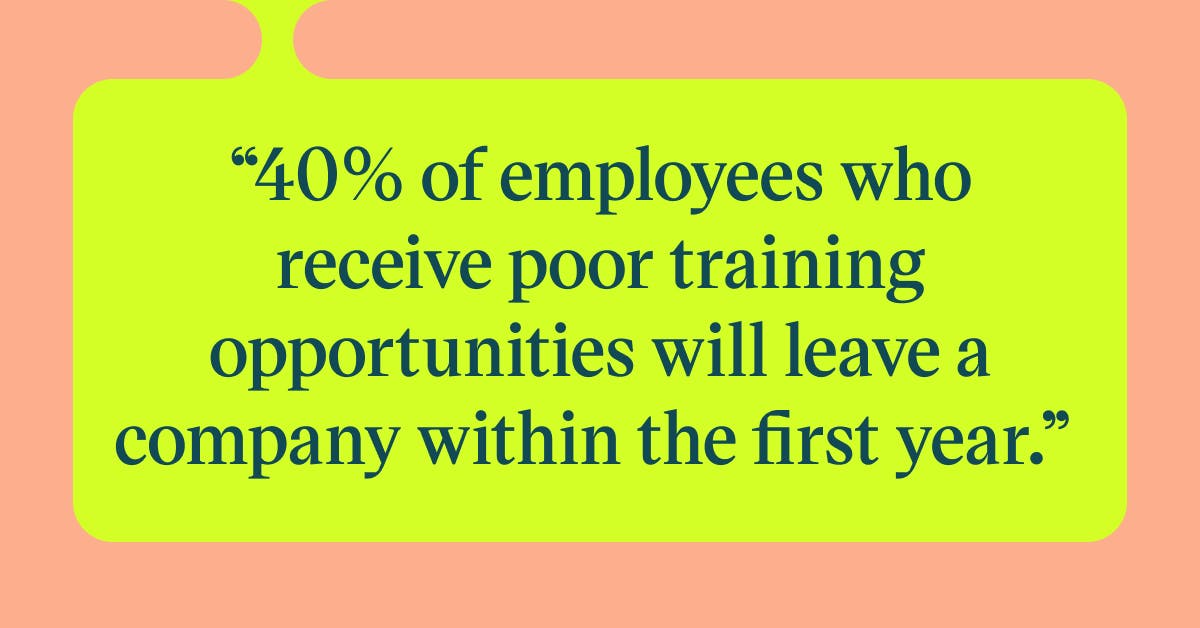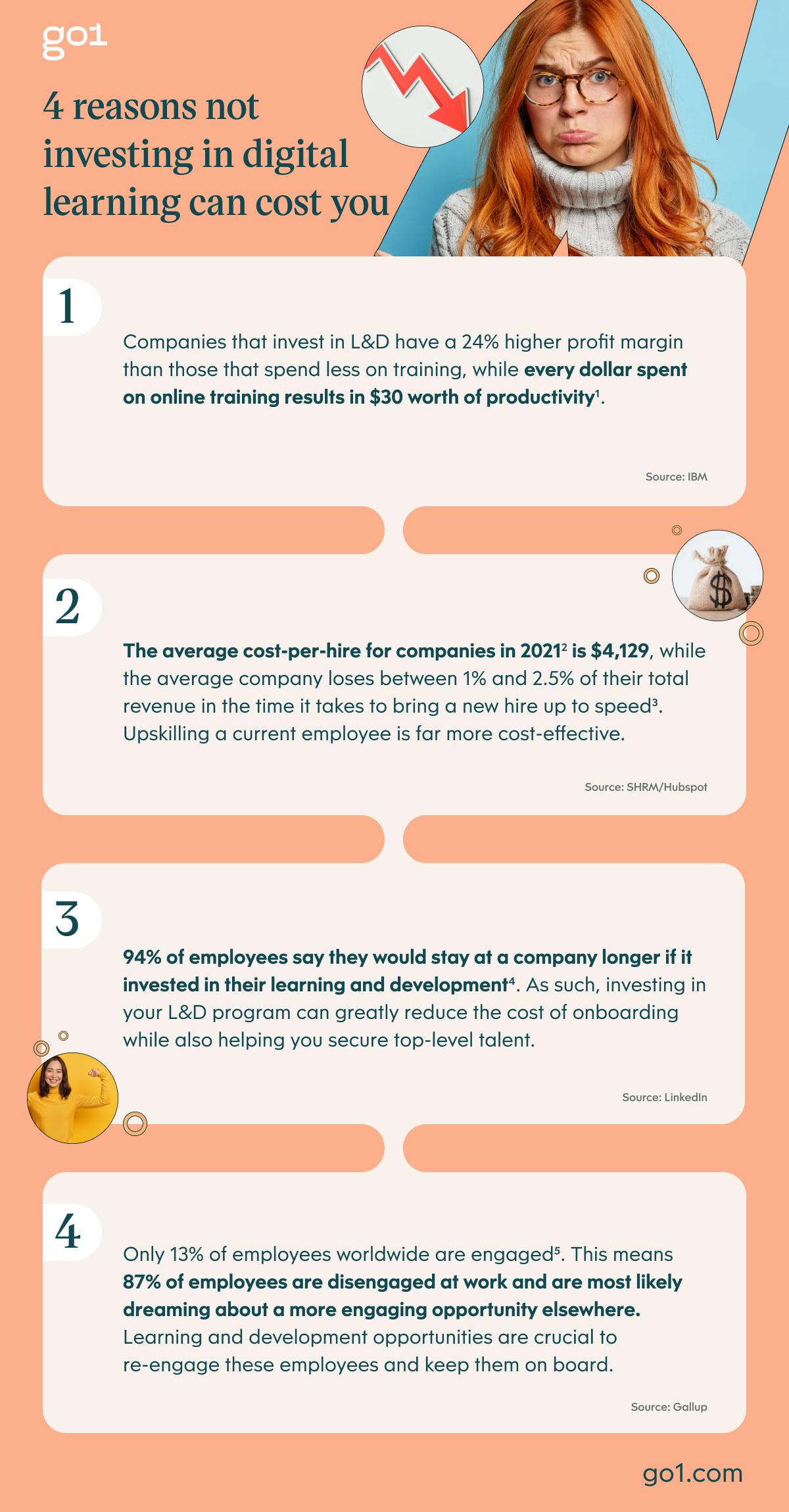
What is the cost of not investing in digital learning?

In 2021, 42% of L&D teams cite “lack of budget” as their biggest challenge. Similarly, 29% of L&D teams say they are “overwhelmed and underequipped.” Anyone who has had to work with limited resources, or try in vain to justify an L&D budget increase, will know exactly how frustrating this can be.
Often, money is tight, so we hear a lot about the cost of investing in digital learning. However, we believe it’s time to flip this scenario on its head and ask, what is the cost of not investing in digital learning?
With that in mind, here are three reasons you can’t afford to not invest in digital learning.
1. The more you put in, the more you get out
While many teams still cite a lack of budget as a roadblock, the overall outlook for L&D budgets is positive. Currently, the global L&D market is worth $367 billion, with estimates saying this will surpass $400 billion by 2025. According to Training Magazine, this equates to $1,111 per employee per year on learning and development. Further, 57% of L&D teams are planning to increase their online budgets in 2021.
The reason for this spending is simple: the more you invest in L&D, the more you will be rewarded. Companies that provide comprehensive training programs have a 218% higher income per employee, according to the Association for Talent Development. What’s more, companies that invest in L&D have a 24% higher profit margin than those that spend less on training.
Additionally, 42% of companies experience an increase in profits after investing in eLearning. A study by IBM puts this into perspective, finding that every dollar invested in online training results in $30 worth of productivity. IBM also found that well-trained teams can increase productivity by 10%.
Given these numbers, it should come as no surprise that 72% of organisations believe that their business gains a competitive advantage by investing in digital learning. With figures like these, not investing in digital learning can be costly, leaving your team under-resourced in important areas.
For further insights on the cost of not investing in digital learning, be sure to read our articles on maximising your L&D budget in 2021 and showcasing L&D’s value.
2. The cost of onboarding, engagement, and retention
When analysing the costs of digital learning, it’s important to remember that it costs significantly more to onboard a new employee than to upskill a current employee.
According to SHRM, the average cost-per-hire for companies in 2021 is $4,129. In other words, replacing an employee can be expensive, costing companies 50-60% of that employee’s salary on average. As Toggl Hire explains, “an average company loses anywhere between 1% and 2.5% of their total revenue on the time it takes to bring a new hire up to speed.”
Given the average turnover rate for all companies is 19% per year, these costs add up quickly. On the other hand, companies with lower turnover rates bring in four times higher profits on average.
In general, most of this turnover is preventable, particularly if teams are willing to invest in digital learning. Work Institute's 2018 Retention Report found that nearly one-third of all turnover was due to either unsupportive management or a lack of development opportunities.
Given this, companies that invest in digital learning can reduce onboarding costs by increasing employee engagement and retention. According to LinkedIn, a massive 94% of employees say they would stay at a company longer if it invested in their learning and development. For most employees, this was a more decisive factor than receiving a raise. 56% of employees say that career growth and opportunity is more important than salary, according to Forbes. This statistic alone shows how vital a robust and well-funded L&D program can be in retaining employees.

Similarly, 64% of Millennials say that they chose their current jobs because of personal and professional development opportunities, while 68% of employees say training and development is a company’s most important policy.
What’s more, employees who are not engaged in learning are twice as likely to leave a company before they have worked there for three years. 40% of employees who receive poor training opportunities will leave a company within the first year. Given what we know about the costs of turnover, this is an alarming statistic.

In terms of engagement, Gallup finds that only 13% of employees worldwide are engaged. In other words, 87% of employees are disengaged at work and are most likely dreaming about a more engaging opportunity elsewhere. Learning and development opportunities are crucial to re-engage these employees and keep them on board.
Adding to this, 74% of employees feel they aren’t fulfilling their full potential due to a lack of learning and development opportunities. Accordingly, Rapt Media finds that more than $500 billion is lost every year due to employee disengagement.
On the flip side, 42% of workplaces where employees are engaged with L&D also say their employees are also highly engaged overall. Companies with more engaged employees outperform those with disengaged employees by up to 202%.
As such, the answer is simple: a robust L&D program leads to better engagement, higher retention, and lower turnover costs.
3. Invest in your learners
Finally, it is important to analyse how much time employees allocate to digital learning. Currently, two-thirds of employees say that they barely have enough time to do their jobs, let alone engage in professional development. Moreover, 49% of people say they don’t have time to learn at work, according to LinkedIn. This should come as little surprise, given one study finds that the average company provides just 55.4 hours of training per employee per year.
Given what we know about the cost of disengaged employees, this can have significant ramifications. For example, Emerald Works’ 2020 Back to the Future report found that 45% of managers were reluctant to make time for learning within their teams. However, among high-impact learning cultures (the top 10% of surveyed organisations), this more than halved to just 21%. Therefore, giving your employees more time to learn can have business-wide benefits.
A study by LinkedIn corroborates these findings, explaining that compared to employees who spend less than one hour per week on digital learning, “employees who spend over five hours per week learning are more likely to know where they want to go in their careers, find greater purpose, and feel less stressed.”
In 2019, during their annual ‘Learning Challenge Week’, LinkedIn also doubled their employees’ daily learning goal from 15 minutes to 30 minutes. This increase in learning time led to 44% more engaged learners and 50% more course views. If these numbers can be achieved from 30 minutes of digital learning every day for a week, imagine what organisations could achieve with a long-term commitment to make time for digital learning.
4 reasons not investing in digital learning can cost you
With that in mind, here is a wrap up of 4 reasons not investing in digital learning can cost you, so that next time someone asks you 'how much will it cost?', you can hit back with 'what is the cost of not investing in digital learning?'

For more insights, be sure to subscribe to the Go1 newsletter to stay on top of all the latest L&D trends. Or, you can book a demo today to find out how Go1 can help with your team’s learning needs.




